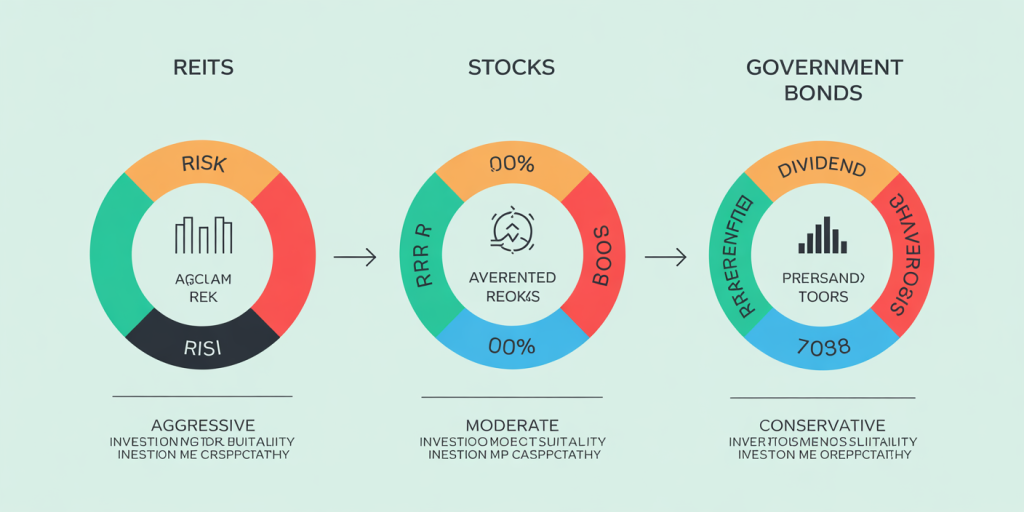REITs, Stocks or Government Bonds? Find Out What Fits Your Profile
Anúncios
Navigating the intricate world of investments often leads individuals to a crossroads: choosing between Real Estate Investment Trusts (REITs), stocks, or government bonds. Each asset type offers unique advantages, risk profiles, and return potentials, making it essential to align investments with your financial goals, risk tolerance, and investment horizon. Understanding the nuances of these options can empower you to make informed decisions that fit your personal financial profile.

To illustrate this, consider the varied experiences of three investors: Lisa, a 30-year-old aggressive investor seeking growth; Tom, a 45-year-old balancing income and moderate growth; and Elaine, a 60-year-old focusing on low-risk income streams for retirement. Each of them would benefit differently from REITs, stocks, or government bonds. Let’s delve deeper into these investment vehicles and uncover which aligns best with different investor profiles.
Anúncios
Understanding REITs: Access Real Estate Without the Hassle
Real Estate Investment Trusts (REITs) are companies that own, operate, or finance income-generating real estate across sectors like residential, commercial, industrial, and healthcare properties. Unlike direct real estate ownership, REITs provide liquidity by trading on major stock exchanges, making real estate investment accessible to those without large capital or the desire to manage physical properties.
REITs generally distribute at least 90% of their taxable income to shareholders as dividends, making them attractive for income-focused investors. For example, the Vanguard Real Estate ETF (VNQ), representing diversified REITs, averaged a dividend yield of approximately 4.1% over the past five years, often outperforming traditional stocks in dividend income. However, they carry risks such as sector-specific downturns—consider the impact of the COVID-19 pandemic on retail and hospitality REITs.
Tom, the middle-aged investor looking for steady income and potential growth, might find REITs appealing due to their dividends combined with exposure to real estate appreciation. On the other hand, Lisa’s younger profile with a high-risk tolerance might incorporate REITs as a diversification tool within a broader stock portfolio.
The Stock Market: Growth Potential with Volatility
Stocks represent ownership in a company, and investing in them offers the opportunity for capital appreciation and dividends. The stock market historically delivers an average annual return of about 7-10% after inflation, making it a favored vehicle for long-term growth. However, stocks come with higher volatility; the S&P 500, for example, has experienced several significant drawdowns, including a 34% drop during the 2020 COVID crash.
Stocks are best suited for investors like Lisa who can tolerate market swings and have a longer time horizon. Growth stocks, such as Tesla or Amazon, may not pay dividends but provide capital gains potential, while dividend stocks like Johnson & Johnson offer a blend of income and growth. The diversification within sectors also allows tailoring risk, from defensive utilities stocks to cyclical technology firms.
Consider Elaine, more risk-averse and nearer to retirement. She might hold a conservative stock allocation focusing on dividend-paying blue-chip stocks for steady income without the volatility of growth stocks but still higher risk than bonds. The key with stocks is balancing potential returns and risk relative to time and income needs.
| Investment Type | Average Annual Return (10 years) | Typical Dividend Yield | Volatility (Standard Deviation) | Suitability |
|---|---|---|---|---|
| REITs | 8.5% | 4-5% | Moderate | Income-focused, moderate risk |
| Stocks (S&P 500) | 10.7% | 1.5-2% | High | Growth, long-term horizon |
| Government Bonds | 2-4% | 1-3% | Low | Capital preservation |
(Source: Morningstar, Federal Reserve Economic Data)
Government Bonds: Safety and Stability in Uncertain Times
Government bonds are debt instruments issued by national governments to finance spending. They are considered among the safest investments because they are backed by the government’s credit. U.S. Treasury bonds, in particular, are regarded as the “risk-free” benchmark in global finance.
These bonds provide fixed interest payments (coupons) and return principal at maturity, appealing especially to risk-averse investors or those needing predictable income. For example, 10-year U.S. Treasury bonds yielded around 3.5% in early 2024, a rate lower than the historical average but offering safety amid inflation concerns and market uncertainty.
Elaine’s profile fits well with government bonds as she prioritizes capital preservation and steady income, particularly important as she nears or enters retirement. Bonds can act as a buffer against stock market volatility, reducing portfolio risk. Tom, balancing growth and income, might allocate a portion of his portfolio to bonds for diversification and stability, especially in economic downturns.
A practical case is the 60/40 portfolio model popularized by Harry Markowitz, where 60% stocks and 40% bonds historically reduced volatility and improved risk-adjusted returns. However, with current low yields, investors must cautiously evaluate how much government bond exposure suits their income needs versus inflation risks.
Matching Investments with Your Risk Tolerance
Investors’ risk tolerance varies widely and significantly impacts the suitability of REITs, stocks, or government bonds. A psychometric approach often categorizes investors as conservative, moderate, or aggressive.

Conservative investors like Elaine seek preservation and stable income; government bonds fit this profile. A portfolio containing 70% bonds and 30% REITs or dividend stocks might fit her needs for safety and mild income growth.
Moderate investors such as Tom can handle moderate volatility while desiring income plus growth. A balanced mix including 40% stocks, 40% bonds, and 20% REITs could provide robust returns without excessive risk.
Aggressive investors like Lisa embrace volatility aiming for higher growth. They might allocate 80-90% in stocks, including international and sector-specific shares, and perhaps 10-20% in REITs for diversification into real estate’s income potential, generally avoiding bonds.
Understanding your behavioral bias towards risk ensures your portfolio suits your comfort level, reducing the chance of panic selling during downturns. Tools like the FINRA Investor Education Foundation’s risk tolerance quiz offer practical ways to assess your profile.
Income Generation Versus Capital Appreciation: Which is Your Priority?
Another vital consideration is whether you prioritize income or capital appreciation. REITs and government bonds lean towards income generation, providing reliable dividends or interest payments. For retirees or those desiring monthly cash flow, these are compelling options.
For example, the iShares U.S. Real Estate ETF (IYR) had a trailing 12-month yield of 3.8% as of 2023, outpacing many bonds. However, REIT yields fluctuate with market dynamics, unlike fixed bond coupons. Government bonds provide predictable, though often lower, income, ideal for conservative investors.
Stocks, particularly growth stocks, focus on capital appreciation over dividends. Amazon’s stock price grew over 30,000% since its IPO, but its dividend yield is near zero. Conversely, dividend aristocrats like Procter & Gamble offer modest growth with steady dividends.
Investors seeking a hybrid approach might consider dividend-paying stocks and REITs combined with bonds for income and some capital appreciation. For instance, Elaine might use dividend stocks and government bonds, while Tom might prefer REITs plus a mix of both dividend and growth stocks.
Future Perspectives: The Evolving Landscape of Investments
Looking ahead, all three investment vehicles face both challenges and opportunities shaped by global economic trends.
REITs are evolving with technology and demographic shifts. The growth of e-commerce has pressured retail REITs, but industrial and logistics-focused trusts are booming due to rising online shopping. Additionally, data center REITs like Digital Realty have surged amid the digital transformation era. Investors seeking exposure to future real estate trends may find specialized REIT sectors promising.

The stock market continues benefiting from innovation in technology, healthcare, and renewable energy sectors. However, investors must monitor geopolitical risks, regulatory changes, and inflationary pressures that could increase market volatility. The rise of environmental, social, and governance (ESG) investing is reshaping corporate priorities, influencing stock valuations.
Government bonds, long considered safe havens, grapple with low yields in many developed economies. Central bank policies, inflation rates, and sovereign debt levels will shape future returns. Inflation-protected bonds like TIPS could offer partial solutions for maintaining real income. Emerging market bonds present higher yield albeit with more risk, appealing to moderate investors wanting yield diversification.
In conclusion, balancing these asset classes requires ongoing evaluation of personal circumstances and market conditions. Building a diversified portfolio tailored to your risk profile, income needs, and growth expectations increases the likelihood of meeting your financial goals over time. Whether REITs, stocks, or government bonds dominate your portfolio, staying informed and flexible will be critical as the investment landscape evolves.
